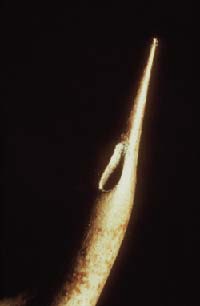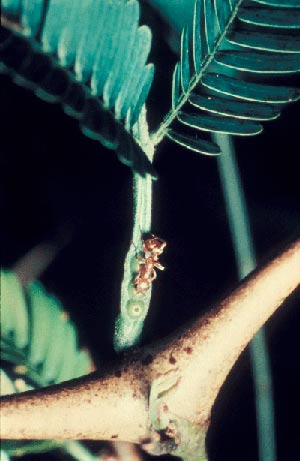 Acacias
around the world - from Africa, America and Australia - have evolved
special relationships with some types of ants. These are remarkable,
symbiotic associations, where both the acacia and the ant benefit. There
are the 'swollen thorn' acacias that provide ant living quarters, and
acacias that have little nutritious pimples at the tips of their leaflets
and large glands on their leaves that secrete ant food. Why is this
so?
Acacias
around the world - from Africa, America and Australia - have evolved
special relationships with some types of ants. These are remarkable,
symbiotic associations, where both the acacia and the ant benefit. There
are the 'swollen thorn' acacias that provide ant living quarters, and
acacias that have little nutritious pimples at the tips of their leaflets
and large glands on their leaves that secrete ant food. Why is this
so?
In Central and South America can be found the Bull's Horn acacia Acacia collinsii. Many species of acacia in Africa and America have long strong thorns to defend against browsing animals, but the Bull's Horn acacia is a particularly spectacular example. The Bull's Horn acacia is covered and armed with large sharp two pronged barbs resembling bull's horns, these are actually enlarged stipules. These large thorns do provide good protection from large grazing animals but provide little deterrent to small insects that may pop by to chew leaves and suck sap. Instead these thorns provide a home to a very efficient guard. Want to know about wattle warfare? Read on!
A fertilised queen ant will land on the thorn, gnaw a hole in the end, crawl inside, and lay her eggs. The worker ants of this colony patrol the leaves, killing and eating any leaf eating insects that stop for a feed. They also patrol around the base of the plant killing any seedlings that could compete with their tree. If any surrounding branches touch the host plant the ants will cross over and attack the leaves and buds so severely that the branch will die back.

Acacia ant hole. Photo: Dan Janzen
As the queen continues to lay, the colony will grow and these new workers take up lodgings in thorns in other shoots of the tree. Eventually the time comes when two colonies on the same tree will meet. Then the battle begins, with rival armies ferociously severing limbs and throwing bodies off the tree.
These ant armies are not just fighting for their homes inside the thorns. They are also fighting for a very special food and drink that the acacia provides. While the host plant does reward the ants for these services by providing a secure home, it also supplies a rich food source for the adult ants and larvae. Nectar is secreted at the base of the leaves all year round for the ants. And at the tips of the leaflets the plant produces small orange beads which are rich in fat. These are collected by the ants, cut up, and fed to the larvae.
Such lavish hospitality indeed for ants in the wattle plants!
Without the presence of the ants, this wattle would not flourish.
 African
acacia species also entertain ants, supplying the ant colony with sugary
secretions from glands all year round. Here again the ants live in the
swollen thorns of these acacias. These African plants are called Whistling
Thorn Acacias because of the sound the wind makes as it blow over the
holes cut by the ants. Antelope will not chomp on an acacia if it knows
it will get bitten on the nose by an angry ant in the process!
African
acacia species also entertain ants, supplying the ant colony with sugary
secretions from glands all year round. Here again the ants live in the
swollen thorns of these acacias. These African plants are called Whistling
Thorn Acacias because of the sound the wind makes as it blow over the
holes cut by the ants. Antelope will not chomp on an acacia if it knows
it will get bitten on the nose by an angry ant in the process!
Passage through an animal's gut is essential for some acacia seeds. That acacia whose umbrella shape is so typical of the plains of East Africa has its seeds in small twisted pods. These seeds are rich in protein and many of the plant eating animals there relish them. The seeds that remain uneaten on the ground seldom, if ever germinate, whereas those that are swallowed with the pods and pass through an animal's digestive system nearly always do. It was thought that the digestive juices were important in getting the seeds to grow. But not so it seems. When the acacia tree sheds it pods, large numbers of small beetles fly in, pierce the pods and lay their eggs inside. These eggs hatch into grubs that eat the seeds. But if the pods are eaten by elephants instead, these Bruchid grubs are killed stone dead.
So when the seeds finally plonk back to the outside world in the elephant's droppings, they have been freed from their insect pests.
Elephant sized insecticides!
In Australia there are many wattle and animal interactions.
Sugar gliders and squirrel gliders are possums that favour dense patches of wattle to live. They feed on the gum that exudes from these trees, and eat the insects that come to feed on the blossoms. The Leadbeaters possum (Victoria's faunal emblem) was thought to be extinct until, in 1961, its colonies were found amongst the maturing wattles regenerating after the 1939 wildfires. These little possums of the mountains feed on the gums of Silver Wattle (Acacia dealbata) and Hickory Wattle (Acacia obliquinervia).
Pollen and sweet secretions are a popular food source. Birds and butterflies visit the pollen rich flowers and nectar secreting glands of the phyllodes. Flowers are, after all, designed to be attractive so that pollinators will visit. The bright colour and sweet scent of wattle flowers advertise quite loudly to the world. And these pollinators ensure that the flowers get their job done: making seeds.
 The
shiny black seeds are eaten by parrots and native pigeons. Galls found
on many wattles are the result of small insects, especially wasps, laying
their eggs which soon hatch into larva. Black Cockatoos and Gang Gangs
love to tear open the bark of wattles, searching for grubs in the wood
of older wattle trees.
The
shiny black seeds are eaten by parrots and native pigeons. Galls found
on many wattles are the result of small insects, especially wasps, laying
their eggs which soon hatch into larva. Black Cockatoos and Gang Gangs
love to tear open the bark of wattles, searching for grubs in the wood
of older wattle trees.
And let's not forget about those ants again.
In Australia, ants and acacias have a common ecological story to tell too.
But Australia does not have that abundance of large herbivores found in Africa. Big spines are not needed here. What is Australia's ant story?
It seems ants have a considerable effect on both seed survival and germination.
It goes like this.
On the hard black shiny seed coat can be found an oily fleshy outgrowth known as an aril. Ants love to eat this. They take the whole seed back to their nests. Back at the nest the ants eat only the aril. So when ants collect the fallen seeds they are actually dispersing them safely. Safe from seed eating birds and mammals, tucked away in the sub soil, perhaps to lie there and wait until the next bushfire, when that hard seed coat will be cracked open, ready to receive the rain and grow into a new generation of Wattles.
Other ants foraging on species of Mulga (Acacia aneura) feed from the tiny glands near the base of the phyllodes. These glands - extrafloral nectaries - secrete a kind of nectar.
Why the wattle should supply generously a food that costs a lot to produce in a dry climate is not clear. One theory is that these glands divert insect eyes from the tree's small delicate flowers and so prevent damage at seed setting time.
There is also another slant to this wattle/ant interaction story.
Some ants have evolved an ingenious method of storing this nectar as the nectar does not always flow.
Worker ants will gather the nectar when available in the crops just behind their mouthparts. They then carry this to their nest not far from the base of the tree. Inside the nest hanging from the ceiling are what looks like transparent baubles. They are in fact ants with hugely distended bellies. Living honeypots! The incoming worker ants regurgitate their sweet cargo into the mouths of the storage ants. When the mulga's nectar flow ceases, the colony turns to its living stores. Colony members in search of food stroke the storage ants with their antennae and get a drop of nectar. Tickle me you sweet thing!

Ant enjoying gland secretions. Photo: Dan Janzen
Wattle You know wattle you do?
- Look for ants on a wattle.
- Retell the Bull's Horn acacia and ants story in a cartoon series.
- Leadbeater possum rediscovery story: Search for "Leadbeater possum" on the Department of Sustainability and Environment website (www.dse.vic.gov.au).
- Visit the "Unforgettable Wattles" website and learn more about ants and Acacias.